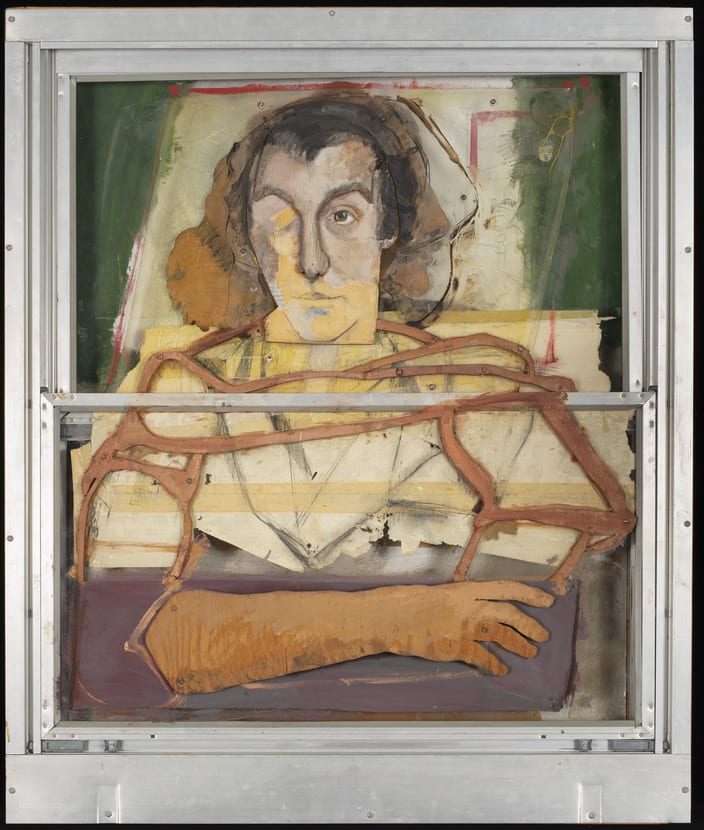
- Artist/Maker:
- Larry Rivers
- Bio:
- American, 1923-2002
- Title:
- Portrait of Vera List
- Date:
- c. 1965
- Medium:
- Paint, charcoal, wood, tape, Plexiglas, and aluminum window frame
- Dimensions:
- 32 × 27 × 4 in. (81.3 × 68.6 × 10.2 cm)
- Credit Line:
- Gift of Vera G. List
- Accession Number:
- 1984-21
- Copyright:
- Art © Estate of Larry Rivers/Licensed by _VAGA_, New York, NY
Not On View
Painter, sculptor, printmaker, poet, and musician Larry Rivers (born Yitzroch Loiza Grossberg) created works of distinguished versatility that enabled him to synthesize elements from the visual, literary, and performing arts. He was a jazz saxophonist before he took up painting, at the encouragement of two artist friends. His roots in improvisational jazz, with its anti-establishment ideology and inventive thematic variations, would later inform his paintings and mixed media constructions. He served briefly (1942-43) in the U.S. Army in World War II, and he studied with Hans Hofmann in 1947-48 in New York and Provincetown, Massachusetts. Rivers abandoned his initial Abstract Expressionist style after seeing Pierre Bonnard's retrospective at the Museum of Modern Art in 1948 and applied his drafting skills to figurative subjects related to his personal life and everyday surroundings. At a time when painters rejected representational imagery, Rivers's return to figuration came from his refusal to cut ties to the figurative masters of the past, seeking to situate himself among them by assimilating key aspects of their creative legacy. His 1950s works, with their sketchy paint application, combined elements of painting and drawing. In the 1960s, Rivers was criticized for appropriating themes and imagery from the work of Old Masters; however, his seemingly irreverent references stemmed from his obsession with examining history, particularly his own artistic and cultural heritage. This would culminate in the large-scale works History of the Russian Revolution: From Marx to Mayakovsky (1965) and History of Matzah (The Story of the Jews) (1982-84).
Vera G. List (1908-2002), a life trustee of the Jewish Museum, was an active collector and champion of contemporary art. In Rivers's Portrait of Vera List, the artist immortalized his patron without idealizing her. One of Rivers's early three-dimensional assemblages, this work is roughly fashioned and retains his characteristic gestural brushwork. Through the convention of portraiture, Rivers engaged in a dialogue with his artistic forefathers, while updating their traditional practices with new materials and techniques. In this half-length portrait, the collage elements, which include painted pieces of wood, Plexiglas, and torn sheets of graph paper, were applied on top of and behind the panes of a storm window to create a disjointed portrait of List. Rivers exploited the window's sliding panes, which can be moved to reveal different images. On the one hand, Rivers literalized the notion that a painting is like a window, offering a view into an imagined pictorial world; however, he did not adhere to the conventions of illusionistic painting. The work's composite views and fragmentation of the sitter's facial features and body parts prevent a coherent reading of the person depicted. This use of collage and fragmentation shows the artist's affinity with earlier avant-garde movements, such as Dada and Cubism, while the innovative use of materials and mixed media, as well as the conflation of high and low culture, coincides with the chief concerns of the contemporaneous Pop Art movement. This portrait conveys the deftly complex yet unfinished qualities of Rivers's distinctive style.
Vera G. List (1908-2002), a life trustee of the Jewish Museum, was an active collector and champion of contemporary art. In Rivers's Portrait of Vera List, the artist immortalized his patron without idealizing her. One of Rivers's early three-dimensional assemblages, this work is roughly fashioned and retains his characteristic gestural brushwork. Through the convention of portraiture, Rivers engaged in a dialogue with his artistic forefathers, while updating their traditional practices with new materials and techniques. In this half-length portrait, the collage elements, which include painted pieces of wood, Plexiglas, and torn sheets of graph paper, were applied on top of and behind the panes of a storm window to create a disjointed portrait of List. Rivers exploited the window's sliding panes, which can be moved to reveal different images. On the one hand, Rivers literalized the notion that a painting is like a window, offering a view into an imagined pictorial world; however, he did not adhere to the conventions of illusionistic painting. The work's composite views and fragmentation of the sitter's facial features and body parts prevent a coherent reading of the person depicted. This use of collage and fragmentation shows the artist's affinity with earlier avant-garde movements, such as Dada and Cubism, while the innovative use of materials and mixed media, as well as the conflation of high and low culture, coincides with the chief concerns of the contemporaneous Pop Art movement. This portrait conveys the deftly complex yet unfinished qualities of Rivers's distinctive style.
Information may change as a result of ongoing research.